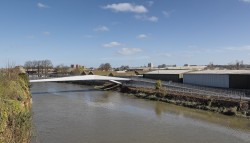The St. Philips pedestrian and cycle bridge in Bristol spans the River Avon. It’s offsite design and installation contributed much needed accessibility to an isolated area.
The new St. Philips pedestrian and cycle bridge is one of two pieces of infrastructure recently built in Bristol to increase the city’s sustainable transport network and to improve accessibility to Temple Island, a centrally-located area behind Temple Meads railway station restricted to rail-related uses for more than 150 years.
The new crossing spans the watercourse, connecting the area with a riverside pedestrian and cycle path. The footbridge connects two banks with a significant difference in elevation (approximately 5m), appearance (historic stone wall with relieving arches and green slope), ground conditions and accessibility. The footbridge – a 50m-span and 4m-wide steel beam with a forked geometry – seamlessly hosts a ramp for disabled users and cyclists and a staircase to maximise functionality in a very limited space. The challenge for the location of the bridge over a river with a 5m tidal range and especially soft ground and limited access in one of the banks, were significant constraints for the design, the material choice, and the decision to maximise offsite construction in the project. Bridge supports within the river and the tidal zone were rejected early in the design process to minimise the impact in an environmentally sensitive area.
Offsite steel fabrication was the perfect approach to precisely realise the large, complex and sculptural multifaceted geometry, combined with enough lightness for installation in a single piece using a crane on just one of the banks. The bridge was fabricated in sections in the workshop, transported to site by road, and then assembled on Temple Island before being lifted into place with lattice boom mobile crane with a maximum capacity of 750t.
The bridge was designed as a sculpted shape to compactly respond to such a constrained crossing. The innovative steel beam with a forked geometry maximises functionality in a very limited space. It naturally guides people along the desire lines and does not restrict potential future connections when the current industrial area will be redeveloped. Offsite construction was crucial for the delivery of such a large and wide object. The inherent cost benefits of offsite construction enabled high-quality architectural design that may not otherwise have been deliverable on budget in that site, by making possible the exacting fabrication of a complex steelwork and its installation in a single crane lift.
The use of offsite technology was a key factor in delivering the project, by significantly reducing the programme, financial and safety risks whilst ensuring a high-quality finish was achieved. The fabrication and assembly of such an atypical steel box girder was extraordinarily challenging due to the number and variability in geometry of the internal longitudinal ribs and diaphragms. To avoid compromising the legibility of the object, external welds and local deformation caused by internal welds should not compete with the edges of the origami shape. The hugely successful result was thanks to the offsite fabrication – which allowed for precise work within tight tolerances – as well as the skills and experience of the steel fabricator and contractor.
The installation of the structure itself, after assembly, was undertaken in a single day, reducing disruption to the construction site and minimising environmental impact. Offsite technology gave greater cost predictability for the contractor, meaning there was less risk in the pricing, giving both client and contractor greater cost certainty.
Traditional onsite construction would have been barely feasible, within a reasonable budget, at this location due to limitation in site access and the characteristics of the ground and tidal river. Offsite technology provided extraordinary benefits compared with traditional onsite construction, in terms of programme reduction, financial and safety risk management and quality of the final product.
For more information visit: www.knightarchitects.co.uk









